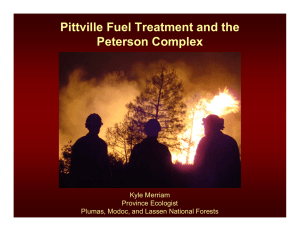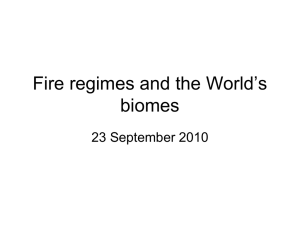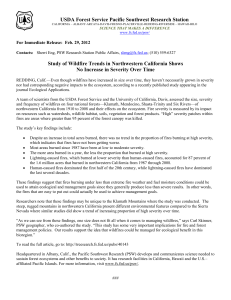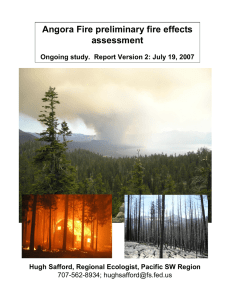Fire and Fuels Monitoring USDA Forest Service Herger-Feinstein Quincy Library Group Monitoring and
advertisement
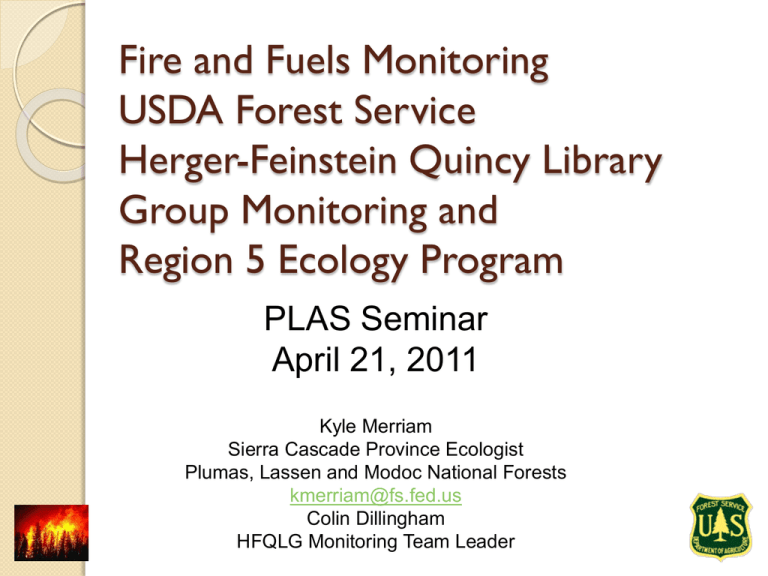
Fire and Fuels Monitoring USDA Forest Service Herger-Feinstein Quincy Library Group Monitoring and Region 5 Ecology Program PLAS Seminar April 21, 2011 Kyle Merriam Sierra Cascade Province Ecologist Plumas, Lassen and Modoc National Forests kmerriam@fs.fed.us Colin Dillingham HFQLG Monitoring Team Leader HFQLG Fuels Monitoring Questions 1.What is the effect of treatments on fire behavior and suppression? 2.What is the trend in large fire frequency? 3.What is the trend in severity of large fires on acres burned? Peterson Fire, Lassen NF Pittville DFPZ TREATED Fire Spread UNTREATED Results: Peterson Fire Severity by Treatment Type 0.9 0.8 0.7 Percent 0.6 Thin Only 0.5 Thin and Burn 0.4 Untreated 0.3 0.2 0.1 0 Scorch Char Crown Scorch Variable Mortality Rich Fire, Plumas NF Untreated Kingsbury Rush DFPZ Untreated Treated Heterogeneity of Fire Effects Kingsbury Rush DFPZ after Rich Fire Sugarloaf Fire, Hat Creek RD Surface fuels treated Surface fuel treatment not completed (but was under contract) Sugarloaf Fire, Hat Creek RD Thin with surface fuels untreated Planned underburn not accomplished Untreated Dow Fire, Eagle Lake RD Thin and Underburn Untreated Mastication Slow rate of spread and low flame length – successful for fire suppression. Fuels concentrated on ground – high tree mortality Antelope Complex, Plumas NF Untreated Treated Antelope Border DFPZ– Untreated Riparian Zones Burned at High Intensity Moonlight Fire – Untreated Owl and Goshawk Habitat Moonlight Fire – Dailey and others 110 100 900 90 80 70 60 50 816 40 777 772 30 20 10 0 -10 N= 725 60 Untreated 58 29 Old Harvest Salv & Mast 77 Com Thin Thin & Burn Treatment Category Untreated North and Hurteau (2010): includes 12 sites in HFQLG area Mechanical Thin R5 Ecology Program Analysis of Seven Fires - Safford and others Peterson 2008 Antelope Complex 2007 Rich 2008 American River Complex 2008 Milford 2009 Angora 2007 Piute 2008 Seven Fires Analyzed: Severity Measures 1 0.9 0.8 Percent 0.7 0.6 0.5 Treated 0.4 Untreated 0.3 0.2 0.1 0 Mortality % Scorch % Torch Percent Severity with transect position 1.2 1 0.8 0.6 0.4 0.2 0 Crown Scorch AmRiv Antelope Peterson Piute Rich Height (m) -5 -4 -3 -2 -1 1 2 3 4 5 Transect Position 14 12 10 8 6 4 2 0 Char Height AmRiv Antelope Milford Peterson Piute -5 -4 -3 -2 -1 1 2 3 4 5 Transect Position Lesson Learned– Thin to reduce Ladder Fuels and Surface Fuel Loading Underburn Biomass Removal Lessons Learned (cont.) Thinning including prescribed fire most effective Retaining high surface fuels not effective Mastication treatments moderate fire behavior but result in high mortality Treatments allow suppression forces to focus on high priority areas Consider treatment options to protect Riparian and PAC areas Acknowledgements Kathy Murphy and Pete Duncan Hugh Safford and R5 Ecology Program Scott Abrams, Ryan Bauer, Sid Beckman, Ruby Burks, Dierdre Cherry, Scott Dailey, Todd Decker, John Estes, Jo Ann Fites, Robert Haug, John Holcomb, Jon Lamb, Debbie Mayer, Jason Moghaddas, Sylvia Mori, Malcolm North, Alicia Reiner, Bruce Troedson, Jason Vermillion, Michael Wintch HFQLG Fuels Monitoring Questions 2. What is the trend in large fire frequency? 3. What is the trend in severity of large fires? Fire Perimeter Mapping Fire Size: QLG Area Fire Size: California CalFire-FRAP, draft 2010 Fire Severity Mapping Fire Severity: QLG Project Area Fire Severity: Sierra Nevada All Forest Types R2 = 0.465, P(lin.) = 0.006 70 100000 50 10000 40 Ha % High Severity 60 30 1000 20 10 0 1982 100 1987 % High Severity 1992 1997 10Yr Moving Avg 2002 2007 Mapped Burned Ha HFQLG Fuels Monitoring Questions 2. What is the trend in large fire frequency? • increasing 3. What is the trend in severity of large fires? • increasing DFPZ Mapping 2008 2008 Questions Were starts inside of DFPZs less likely to develop into fires (5 acres or more)? Were starts closer to DFPZs less likely to develop into fires? Was fire size related to start distance from DFPZ? Starts 400 350 39 300 250 Fire 200 307 150 100 50 0 32 Inside DFPZ Outside DFPZ No Fire Start Distance from DFPZ Start Distance from DFPZ (m) 8000 7000 6000 5000 4000 3000 2000 1000 0 Fire No Fire Frequency (%) Starts ≠ Fires 40 35 30 25 20 15 10 5 0 Distance from DFPZ (m) Start Distance from DFPZ (m) Start Distance and Fire Size 14000 R² = 0.18, p<0.01 12000 10000 8000 6000 4000 2000 0 1 2 3 Fire size (log acres) 4 5 Questions Were starts inside of DFPZs less likely to develop into fires? ◦ YES, starts inside DFPZS did not become fires Were starts closer to DFPZs less likely to develop into fires? ◦ YES, 33% of starts that did not become fires were <500m from a DFPZ Was fire size related to start distance from DFPZ? ◦ YES, starts closer to DFPZS resulted in smaller fires Watershed Mapping How does the amount of the watershed treated affect the area burned? Modeled Results From Moghaddas et al. (2010) Observed Results 20 Watershed Burned (%) 18 R² = 0.15, p<0.001 16 14 12 10 8 6 4 2 0 0 2 4 6 8 Watershed Treated (%) 10 12 Conclusions 1.Large fire frequency and severity is increasing. 2.DFPZs can reduce fire severity and extent at local and watershed scales. 3.Can DFPZs reverse fire trends in QLG area? Climate Projections: Increased Fire Lenihan et al. 2008 Future Opportunities? ◦ Fully implement DFPZ networks ◦ Reduce surface fuels in existing treatments- underburning ◦ Utilize appropriate management response for starts inside DFPZs

